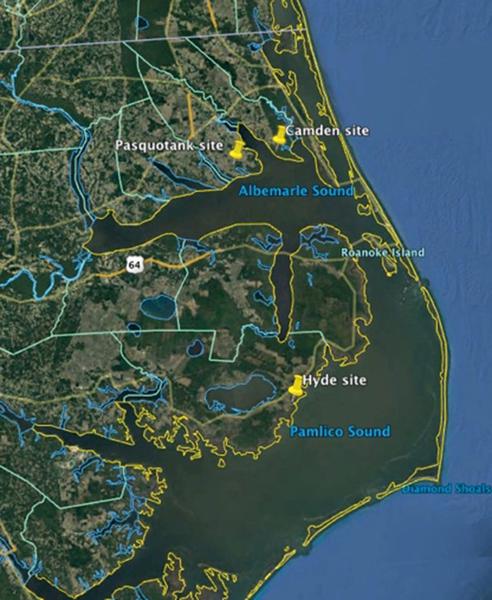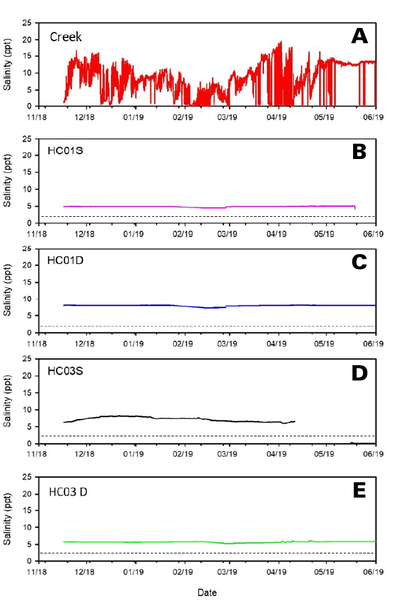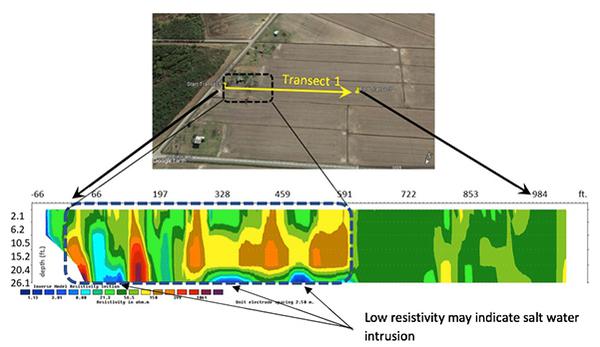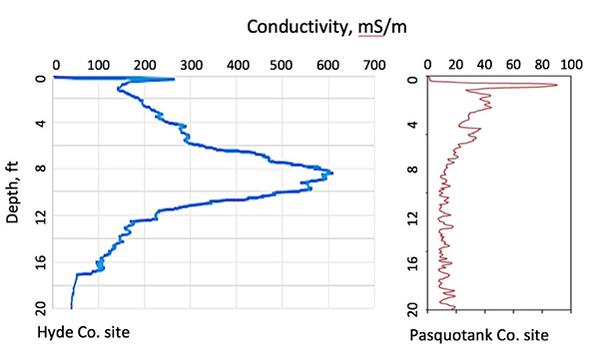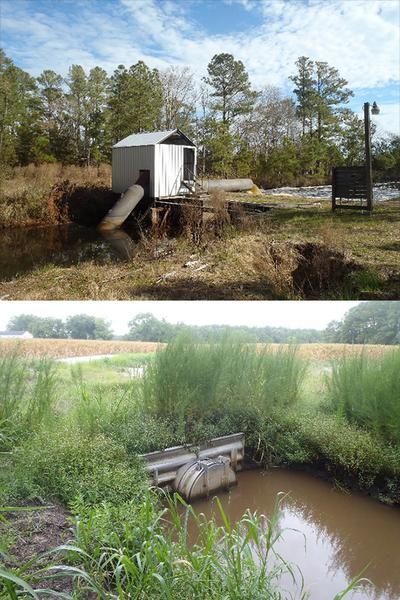Saltwater intrusion is the invasion of coastal soils by salt water from oceans and sounds. Salts are attracted to the soil particles and accumulate in the soil, causing toxicity to nonadapted plants. Excessive salt may also cause clay dispersion and surface sealing, impeding soil drainage. In North Carolina, the main salinization mechanisms are storm surge events, wind-driven flooding through ditch and canal networks, sea level rise, and horizontal saltwater movement through the subsoil.
Measuring Salinity in Salt-Affected Wells and Soils
Researchers recently studied the effects of saltwater on soil, creeks, and wells in and along North Carolina agricultural fields in the coastal counties of Hyde, Pasquotank, and Camden (Figure 1). Well clusters and nearby creeks were used to determine vertical and horizontal variability in salinity of the water. Figure 2 provides data, presented in five graphs, obtained from the Hyde County location. The salinity in the creek (Figure 2A) was highly variable—from 0 to 20 parts per thousand (ppt)—during a seven-month period. The salinity of the water in both well clusters was constant over the same period (Figure 2B, C, D, and E) but higher than the maximum salinity recommended by Brouwer et al. (1985) for irrigation water (2 ppt), represented by dotted lines in Figure 2. In well HCO1, salinity was higher at greater depth (9 feet) (Figure 2C) than at shallower depth (3 feet) (Figure 2B); the reverse was measured in well HCO3 (Figure 2D and E). Thus, salinity in the well water varied by depth and location, even when the wells were located relatively close to one another (Figure 3). Elevated salinity levels in the shallow groundwater indicate the potential for salts to negatively affect the crop performance in this location. The elevated salinity also indicates that it will be difficult to flush the excess salts from the soil profile.
Figure 4 shows a soil map of a Hyde County field affected by salts. The top of the chart is the soil surface and goes to a depth of 26 feet; the blue colors may indicate the influence of salts. The figure shows how variable the salt intrusion into a field may be. The field was 2 feet above sea level and nearly flat. Any elevation changes were in inches.
The distribution of salts in the soil profile was dramatically different throughout the coastal North Carolina fields. Figure 5 shows the soil conductivity at two sites, one in Hyde County and the other in Pasquotank County. Soil conductivity measures the concentration of chemical elements in the soil water; higher conductivity indicates more dissolved salts in the soil water. The Pasquotank County site had a moderate accumulation of salts in the top 5 feet of soil, whereas the Hyde County site had a very high accumulation between 8 and 10 feet deep. Both of the profiles showed a sharp increase in conductivity within the top 6 inches, indicating salt accumulation at or near the soil surface.
Identification and Potential Remediation Options for Salt-Affected Soils
Identify the Problem
Good soil sampling techniques can help determine the cause of decreased productivity in a field (see the NC State Extension SoilFacts publication Effects of Wind-Induced Sodium Salts on Soils in Coastal Agricultural Fields. Collect and analyze separate soil samples from the salt-affected area and from a nearby nonaffected area, then compare the results from both areas. Because salt distribution within a field can be very patchy, pinpointing sampling locations is easiest when visible crop damage or differences in residue cover are still apparent. Crop damage varies with the intensity of salt exposure, but it resembles that caused by drought. Look for stunted growth, small and yellow leaves, death of leaf margins, and leaf drop.
In a soil test report, the exchangeable sodium percentage (ESP) and soluble salts index (SS-I) are of key interest because these parameters are used to diagnose salt-affected soils. In North Carolina, crop damage was observed in fields with ESP of 14 and SS-I of 53 to 120. The North Carolina Department of Agriculture & Consumer Services (NCDA&CS) Agronomic Division laboratory determines the SS-I when the samples are submitted as diagnostic (problem) samples rather than as routine samples. Soil analysis reports from prior years may help determine if a progression in sodium content is occurring at the site. Producers should monitor a field’s soil ESP and SS-I, salinity of irrigation water, and salinity of water in the ditches. North Carolina Cooperative Extension agents can use a producer’s data in recommending remediation solutions.
Potential Remediation Options
Apply gypsum: Gypsum applications have been used in the western desert states in response to salt accumulation from irrigation; applications have also been attempted in some eastern North Carolina fields after storm events. Theoretically, the calcium in the gypsum displaces the sodium closest to the soil particles—that sodium remains dissolved in the soil solution unless sufficient water movement flushes it from the soil profile. For gypsum treatment to be successful, there must be sufficient fresh water and adequate subsurface drainage. Without an efficient natural or artificial subsurface drainage system, the high water table and elevated groundwater sodium concentrations observed in some fields in the northeastern North Carolina counties often make the gypsum treatment less effective. If the salt-affected field has efficient water drainage, incorporating gypsum into the soil and then thoroughly saturating the field with fresh water prior to draining it can increase the chance of remediation.
Conduct deep tillage: Deep tillage has remediation potential in areas where surface crusts have formed but there is no accumulation of salts deeper into the soil profile. Tillage distributes and dilutes the salts, lessening their impact on the plants. Since salts will gradually be mixed deeper and deeper into the profile, deep tillage cannot be continually used unless salts are flushed entirely below the rooting zone.
Grow salt-tolerant crops or crop varieties: Crops vary in their tolerance to salinity (Table 1). Variety trials are continuing in northeastern North Carolina. Asparagus did well in a test plot in spite of salty conditions. Cotton is rated as one of the most salt-tolerant of the extensive field crops commonly grown in northeastern North Carolina. Some soybean varieties are able to secrete salt from their roots, making them more salt-tolerant than other varieties; however, little is known about suitability of these varieties in northeastern North Carolina.
|
|
High Tolerance |
Medium Tolerance |
Low Tolerance |
|
Field crops |
Barley, sugar beet, rapeseed, cotton |
Rye, wheat, oats, rice, sorghum, corn, flax, sunflower, castorbeans, soybeans |
Beans |
|
Forages |
Alkali sacaton, saltgrass, nuttall alkaligrass, bermudagrass, Rhodes grass, Canada wildrye, western wheatgrass, barley, birdsfoot trefoil |
White sweet clover, perennial ryegrass, mountain brome, strawberry clover, dallis grass, sudan grass, hubam clover, alfalfa, tall fescue |
White clover, meadow foxtail, alsike clover, red clover, ladino clover, burnet |
|
Vegetables |
Asparagus, spinach |
Tomato, broccoli, cabbage, bell pepper, cauliflower, lettuce, sweet corn, potatoes, sweet melon |
Radish, celery, green beans, strawberries |
|
Fruit crops |
Date palm |
Pomegranate, fig, olive, grape |
Pear, apple, orange, grapefruit, prune, plum, almond, apricot, lemon, avocado |
|
*In each class, crops are listed in order of salt tolerance. From Diagnosis and Improvement of Saline and Alkali Soils, U.S. Department of Agriculture, Agricultural Handbook No. 60, 1954. |
|||
Manage water aggressively: Dikes and floodgates (Figure 6) can reduce the risk of additional salt inputs to fields from storm surges. Managing water-control structures to retain rainfall on fields flushes the soil with freshwater and enhances the downward leaching of salts. Repeated cycles of freshwater flooding, drainage, and reflooding will maximize salt removal.
Acknowledgments
Funding for this research was obtained from an NC State Extension Gore Innovation Grant and a National Science Foundation RAPID grant, award #1902385. Research was conducted in collaboration with N.C. Cooperative Extension agents and specialists, Camden Soil and Water Conservation District personnel, East Carolina University faculty and students, and cooperating crop producers.
Reference
Brouwer, C., A. Goffeau, and M. Heibloem. 1985. “Irrigation Water Quality.” In Irrigation Water Management: Training Manual No. 1–Introduction to Irrigation, Chapter 7.6.1. Food and Agriculture Organization (FAO) of the United Nations.
Publication date: Aug. 21, 2020
AG-439-89
N.C. Cooperative Extension prohibits discrimination and harassment regardless of age, color, disability, family and marital status, gender identity, national origin, political beliefs, race, religion, sex (including pregnancy), sexual orientation and veteran status.

